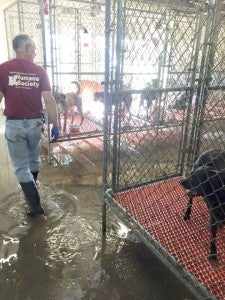Conditions worsening at BDHS shelter
Published 10:50 pm Friday, September 25, 2015
As the Bainbridge-Decatur Humane Society prepares for one of its fund-raising activities, the annual 5K Run to Rescue to be held Saturday, October 3, attention is drawn to the many needs and issues the staff and volunteers face daily.
The 501© 3 organization took over the City of Bainbridge’s all-breed animal shelter November 20, 2004, and began to face head on the challenges of running an adequate shelter.
The antiquated and deteriorating facilities do not begin to address the issues faced in the care of the approximately 2000 animals that come through the shelter doors annually.
According to a needs assessment recently developed in an attempt to obtain a grant, the two metal buildings lack insulation, which results in high electric bills when the weather is very hot from May to September. The aging HVASC systems frequently break down and ventilation is inadequate, as mold and rust enter the air returns, causing a breathing threat to both animals and shelter workers.
Space layout, itself, is a big issue, as the initial design was not intended for the current usage. The interior door of the cat room opens to the largest isolation room for dogs, where the sickest animals are kept.
The larger building houses adoptable animals. Drains in this building are in the walkways next to the kennels. In spite of staff cleaning in and around the kennels four times daily, fecal matter frequently clogs the poorly functioning drains, causing sewer water backups. Staff, potential adopters and dogs removed from the kennels must walk the same wet, concrete path, which exposes all to germs and makes it easy to transmit diseases.
When the shelter is full with both cats and dogs, of necessity they must share a room. At this point euthanization can become the only remedy to the situation.
Cats in both buildings have the constant stress of crammed conditions and the noise of barking dogs without a sound barrier.
This is also an issue for many animals brought in who have been surrendered due to the aging owner’s death or going into nursing care. According to Beth Eck, Kennel Director, these animals become especially stressed out living in the noisy kennel environment.
There is just plain a lack of space. There is not a receiving area to triage animals or provide adequate quarantine for newly admitted animals. There is not a room where prospective adopters may visit and get to know the animal. This usually occurs outside, weather permitting.
“Our kennel does a remarkable job of caring for and placing animals,” according to board member Dennie Nichols, who said “I’m so proud of our rescue operation,” the success of which she attributes to Eck. The shelter works with about 50 different rescue operations. Decisions of which animals to send to rescue are made by Eck, who considers the medical condition, the nature and type of the dog. Nichols calls her “Our dog whisperer.”
The shelter does receive financial support for current operating expenses, but only 49 percent of their annual budget is supplied by the City and County government. The remainder comes through fundraising efforts by the board of directors, as well as individual donations, and membership fees.
Unfortunately, according to board members, all of that money goes to cover operating expenses due in large part to the condition of the buildings and equipment, which require constant repair. There is nothing left to go toward building a new, modern shelter.
The shelter is also in need of a new or used van for transporting animals. Currently they have one vehicle, a 20 year- old van with 215,827 miles on the odometer.
In July 2014, a local citizen and board member, donated five acres of land for a new shelter. In 2015 they kicked-off a major fundraising for a new shelter, when board members sponsored Art for Animals. Over $19,000 was raised from that event. As of July 31, 2015, the Society has raised $54,412 through a Go Fund Me Facebook account, membership renewals, personal solicitations and individual and corporate contributions.
Ed Mitchell has done a preliminary sketch for a building, but it is necessary for the society to hire an architect who specializes in shelter design before the exact amount of money needed will be known. It is estimated that at least $500,000 is needed before construction can begin.
In the meantime they cope as best they can. The next article will show some of the creative ways shelter workers make do on a daily basis.
This is the first of a two-part series concerning the Bainbridge-Decatur County Humane Society. This article spells out the problems dealt with daily. The next article will address who makes up the workers and volunteers, the ways they work with the issues, and educational plans for the future.






